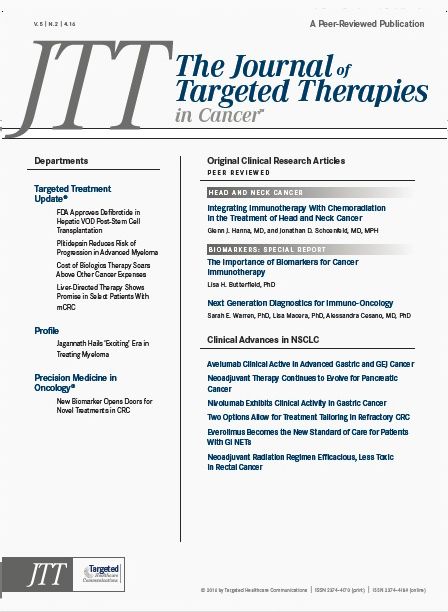Markers of Excellence
The word "marker" is defined, in medical terms, as "something that serves to identify, predict, or characterize." A variation on this word, known as a biological marker, or biomarker (defined as a measurable indicator of a biological condition) takes this concept one step further.
Mike Hennessy
The word “marker” is defined, in medical terms, as “something that serves to identify, predict, or characterize.” A variation on this word, known as a biological marker, or biomarker, (defined as a measurable indicator of a biological condition) takes this concept one step further.
And that’s exactly what we are doing in this issue ofThe Journal of Targeted Therapies, which has a special focus on biomarkers within our section of peer-reviewed articlestaking the exploration of biomarkers as they are applied in cancer research and treatments one step further (actually, many steps further).
This issue’s first peer-reviewed article, “Integrating Immunotherapy With Chemoradiation in the Treatment of Head and Neck Cancer,” looks at the potential benefits of combining chemotherapeutics, radiotherapy, and immunotherapy as a treatment for squamous cell carcinoma of the head and neck (SCCHN). The authors contend that gaining better understanding of the synergy between these approaches in treating SCCHN will result in more rational and improved clinical trials, and could improve outcomes in SCCHN patients in the definitive treatment setting.
The first of the two peer-reviewed biomarkers articles in this issue, “The Importance of Biomarkers for Cancer Immunotherapy,” examines the benefits and limitations of immunotherapy as a cancer treatment strategy. The use of checkpoint blockade with cytotoxic T-lymphocyte-associated protein 4 and programmed death-1 (PD-1) antibodies, and other recently approved biologic drugs, has shown encouraging results in patients. But, there are still toxicities associated with such immunotherapies. Response is not durable in most patients. For this reason, the author feels, there is an urgent need for standardized, validated biomarkers to measure immunotherapy efficacy. Biomarkers that could potentially meet this goal are discussed with great insight in this piece.
Our next biomarkers article, “Next Generation Diagnostics for Immuno-Oncology,” reviews current immuno-oncology therapies, which, the authors attest, are only effective for a small portion of patients. They feel current biomarkers to measure immune response are less than optimal. The use of programmed death ligand 1 (PD-L1) to guide the administration of PD-1 inhibitors, in their view, has low accuracy and analytic challenges. As an alternative, the authors propose the features of an ideal immuno-oncology diagnostic, summarize PD-L1 measurement by immunohistochemistry, and document different biomarkers under development that could revolutionize the practice of immuno-oncology in years to come.
These articles all have the mark of excellence. We hope you enjoy and benefit from them, and from all of the valuable content contained in this issue.

Survivorship Care Promotes Evidence-Based Approaches for Quality of Life and Beyond
March 21st 2025Frank J. Penedo, PhD, explains the challenges of survivorship care for patients with cancer and how he implements programs to support patients’ emotional, physical, and practical needs.
Read More